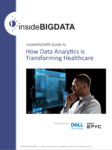In 2022, Businesses Will Lay the Groundwork for to Unlock the Full Power of Data
In this special guest feature, Ankit Patel, SVP of Engineering at Foursquare, offers 4 trends that will help pave the path for businesses to unlock the full potential of data in 2022 which will likely be the year that businesses …
In 2022, Businesses Will Lay the Groundwork for to Unlock the Full Power of Data Read more »








